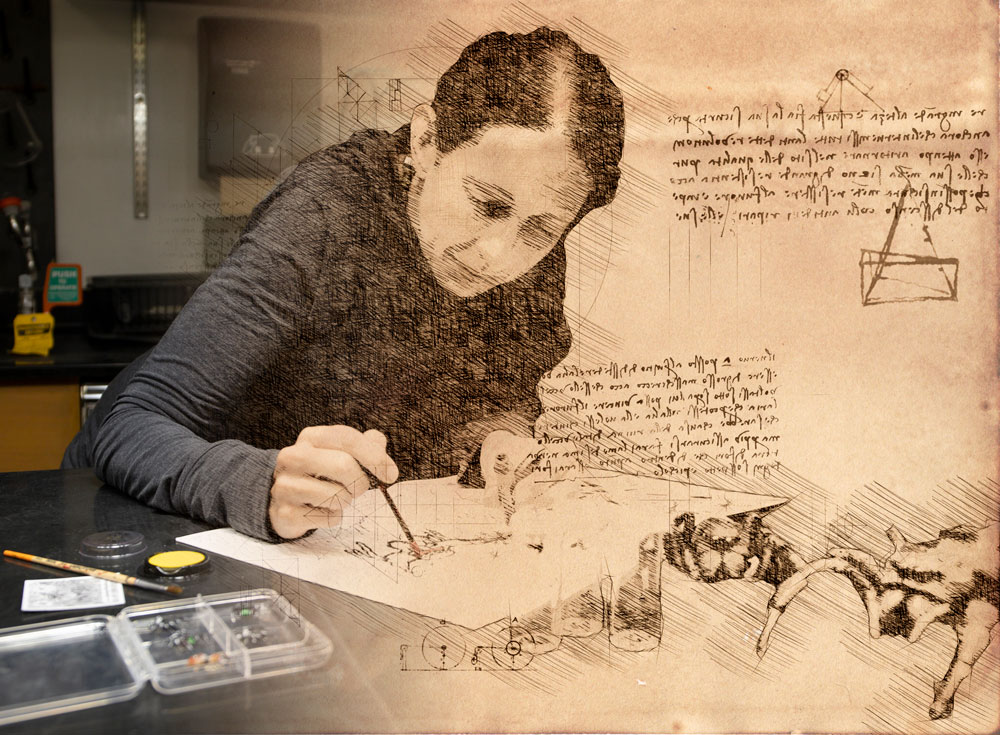This May, the world marks the 500th anniversary of the death of scientist, artist, inventor and innovator, Leonardo da Vinci. In honor of this occasion, UF/IFAS has chosen four faculty members who each exemplify at least one of da Vinci’s four most well-known talents and contributions to society.

Lisa Taylor
Assistant Research Scientist, Behavioral Ecology and Evolution
Department of Entomology and Nematology
Lisa Taylor’s research is driven by a fascination with biodiversity and the extravagant and brilliantly colored displays that arthropods use to communicate. The goal of her work is to understand the selection pressures that drive the evolution and maintenance of these colors. Projects have included spider makeovers and an arachnid coloring book.
Why is the combination of art and science together effective?
I was always interested in art and color when I was younger and I even considered going to art school as a career path. The nature of what we do in the Taylor Lab and the types of questions that we ask are driven by an interest in color.
A lot of what we do involves manipulating the colors of spiders. It’s hard not to have an appreciation for art if you are studying beautiful and colorful spiders.
We also have artists-in-residence in the lab. As scientists we are all trained in similar ways of thinking – we come up with hypotheses and predictions and design experiments to test them. But art students come into the lab with a completely different way of thinking about things. This makes for a great collaboration.
Do just jumping spiders use color?
Most spiders don’t have color vision. But jumping spiders are really unique because they do. There are 6,000 species of jumping spiders and they have different degrees and types of color vision that we are just now discovering. This makes them very different than any other type of spider.
What has your research told you about how science and nature use art and color effectively?
One of the insights we’ve gotten from spiders is the males have evolved these colors on their body in order to communicate with females. Some of the things we are trying to understand are: Why do females pay attention to those colors? Why do males use the particular colors that they do? Why do they pair some colors with others? What it comes down to is color is really good for communicating information quickly. For getting a female’s attention, and in some cases for tricking her.
Females are bigger and they are cannibalistic, and so a male’s colors might help him avoid getting eaten. We think, for instance, the red color on the male’s face and possibly the black and white stripes actually exploit the female’s psychology. We know the females don’t like to eat red things and they don’t like to eat things that are striped. So, we think some of those colors, are actually exploiting the female so the female won’t attack him.
So, all these things we are learning about color in the context of communication and courtship, they have parallels to how we know color operates in our world.
How does science use art to communicate?
Jumping spiders are very diverse, so our scientific mission is just to figure out what’s going on, why colors have evolved the way that they have. Then, our outreach mission is to share what we learn about those particular questions but then also to increase appreciation for spiders in general and jumping spiders in particular.
Spiders are beneficial predators. They eat mosquitoes, flies, plant pests, they are great to have around but people’s initial response when they hear anything about spiders is to step on them because they are perceived as scary.
The idea for the coloring book is to spread appreciation for spiders. The species that are featured are all Florida species and they are also what we consider to be the most charismatic ones.
Has Leonardo da Vinci ever inspired you?
I definitely am inspired by him and people like him who were really good at art and science and were able to learn about the world in both realms rather than being just stuck in one. There isn’t only one way to experience or learn about the world.
-30-
By: April Martin, 352-294-3302, april.martin@ufl.edu
The mission of the University of Florida Institute of Food and Agricultural Sciences is to develop knowledge relevant to agricultural, human and natural resources and to make that knowledge available to sustain and enhance the quality of human life. With more than a dozen research facilities, 67 county Extension offices, and award-winning students and faculty in the UF College of Agricultural and Life Sciences, UF/IFAS works to bring science-based solutions to the state’s agricultural and natural resources industries, and all Florida residents. Visit the UF/IFAS website at ifas.ufl.eduand follow us on social media at @UF_IFAS.
 2
2
